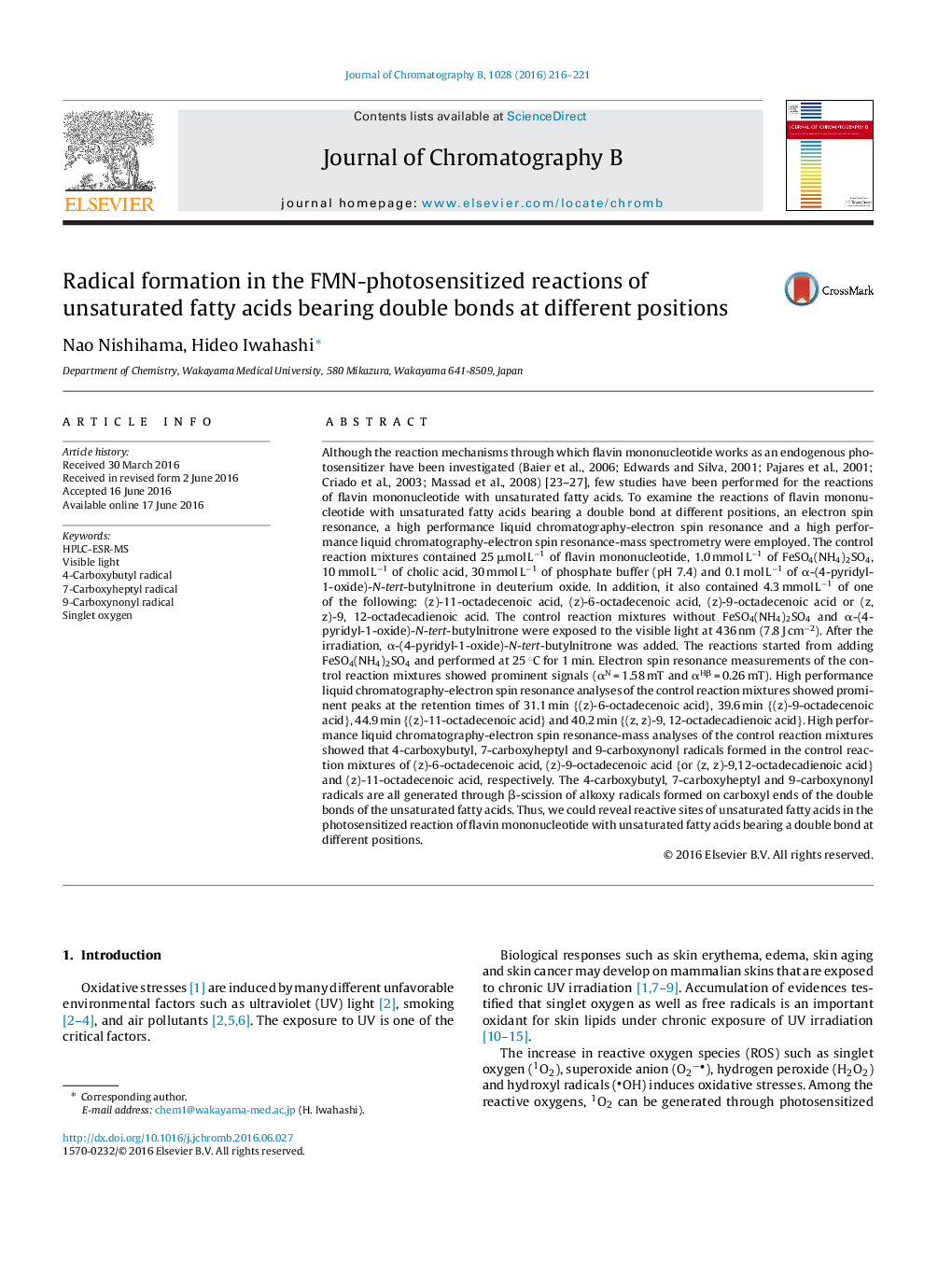| Article ID | Journal | Published Year | Pages | File Type |
|---|---|---|---|---|
| 7615996 | Journal of Chromatography B | 2016 | 6 Pages |
Abstract
Although the reaction mechanisms through which flavin mononucleotide works as an endogenous photosensitizer have been investigated (Baier et al., 2006; Edwards and Silva, 2001; Pajares et al., 2001; Criado et al., 2003; Massad et al., 2008) [23-27], few studies have been performed for the reactions of flavin mononucleotide with unsaturated fatty acids. To examine the reactions of flavin mononucleotide with unsaturated fatty acids bearing a double bond at different positions, an electron spin resonance, a high performance liquid chromatography-electron spin resonance and a high performance liquid chromatography-electron spin resonance-mass spectrometry were employed. The control reaction mixtures contained 25 μmol Lâ1 of flavin mononucleotide, 1.0 mmol Lâ1 of FeSO4(NH4)2SO4, 10 mmol Lâ1 of cholic acid, 30 mmol Lâ1 of phosphate buffer (pH 7.4) and 0.1 mol Lâ1 of α-(4-pyridyl-1-oxide)-N-tert-butylnitrone in deuterium oxide. In addition, it also contained 4.3 mmol Lâ1 of one of the following: (z)-11-octadecenoic acid, (z)-6-octadecenoic acid, (z)-9-octadecenoic acid or (z, z)-9, 12-octadecadienoic acid. The control reaction mixtures without FeSO4(NH4)2SO4 and α-(4-pyridyl-1-oxide)-N-tert-butylnitrone were exposed to the visible light at 436 nm (7.8 J cmâ2). After the irradiation, α-(4-pyridyl-1-oxide)-N-tert-butylnitrone was added. The reactions started from adding FeSO4(NH4)2SO4 and performed at 25 °C for 1 min. Electron spin resonance measurements of the control reaction mixtures showed prominent signals (αN = 1.58 mT and αHβ = 0.26 mT). High performance liquid chromatography-electron spin resonance analyses of the control reaction mixtures showed prominent peaks at the retention times of 31.1 min {(z)-6-octadecenoic acid}, 39.6 min {(z)-9-octadecenoic acid}, 44.9 min {(z)-11-octadecenoic acid} and 40.2 min {(z, z)-9, 12-octadecadienoic acid}. High performance liquid chromatography-electron spin resonance-mass analyses of the control reaction mixtures showed that 4-carboxybutyl, 7-carboxyheptyl and 9-carboxynonyl radicals formed in the control reaction mixtures of (z)-6-octadecenoic acid, (z)-9-octadecenoic acid {or (z, z)-9,12-octadecadienoic acid} and (z)-11-octadecenoic acid, respectively. The 4-carboxybutyl, 7-carboxyheptyl and 9-carboxynonyl radicals are all generated through β-scission of alkoxy radicals formed on carboxyl ends of the double bonds of the unsaturated fatty acids. Thus, we could reveal reactive sites of unsaturated fatty acids in the photosensitized reaction of flavin mononucleotide with unsaturated fatty acids bearing a double bond at different positions.
Keywords
Related Topics
Physical Sciences and Engineering
Chemistry
Analytical Chemistry
Authors
Nao Nishihama, Hideo Iwahashi,
